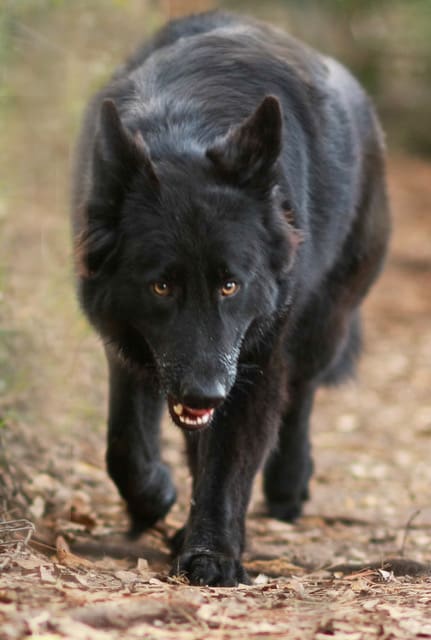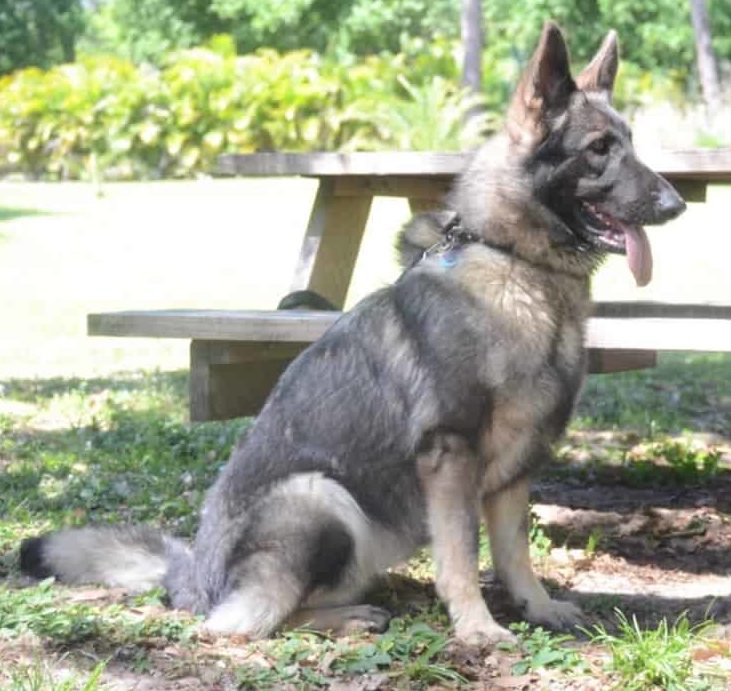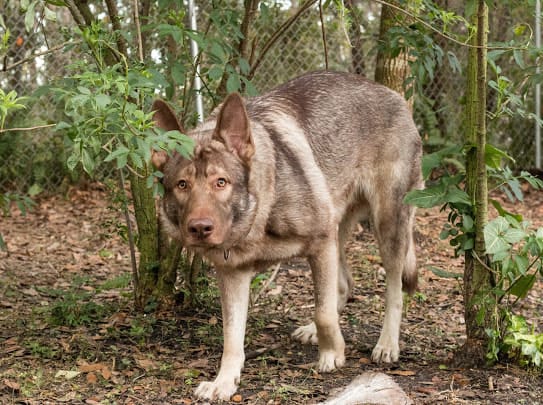When getting a German Shepherd, understanding the range of German Shepherd colors is crucial, as it significantly influences their role and perception.
Is he a family pet? He must look friendly. Will he be a guard dog? He must look intimidating. If entering dog shows, he better look the part. Your dog’s color plays a vital role in all of this.
German Shepherd colors are usually black and red and black and tan. Tan or red can be replaced by liver, white, cream, or silver, whereas black can be replaced by blue or gray. These colors are often distributed in a bicolor pattern, including saddle, blanket-back, sable, and brindle.
In this article, you will learn more about every German Shepherd color, including the various combinations, their rarity, how the dogs look, and their best use.
You will also learn more about the distribution of these colors and the patterns you can expect a German Shepherd to have.
Each section also includes a “best for” verdict that highlights my recommendation for who the specific dog is best suited for.
Let’s get started!
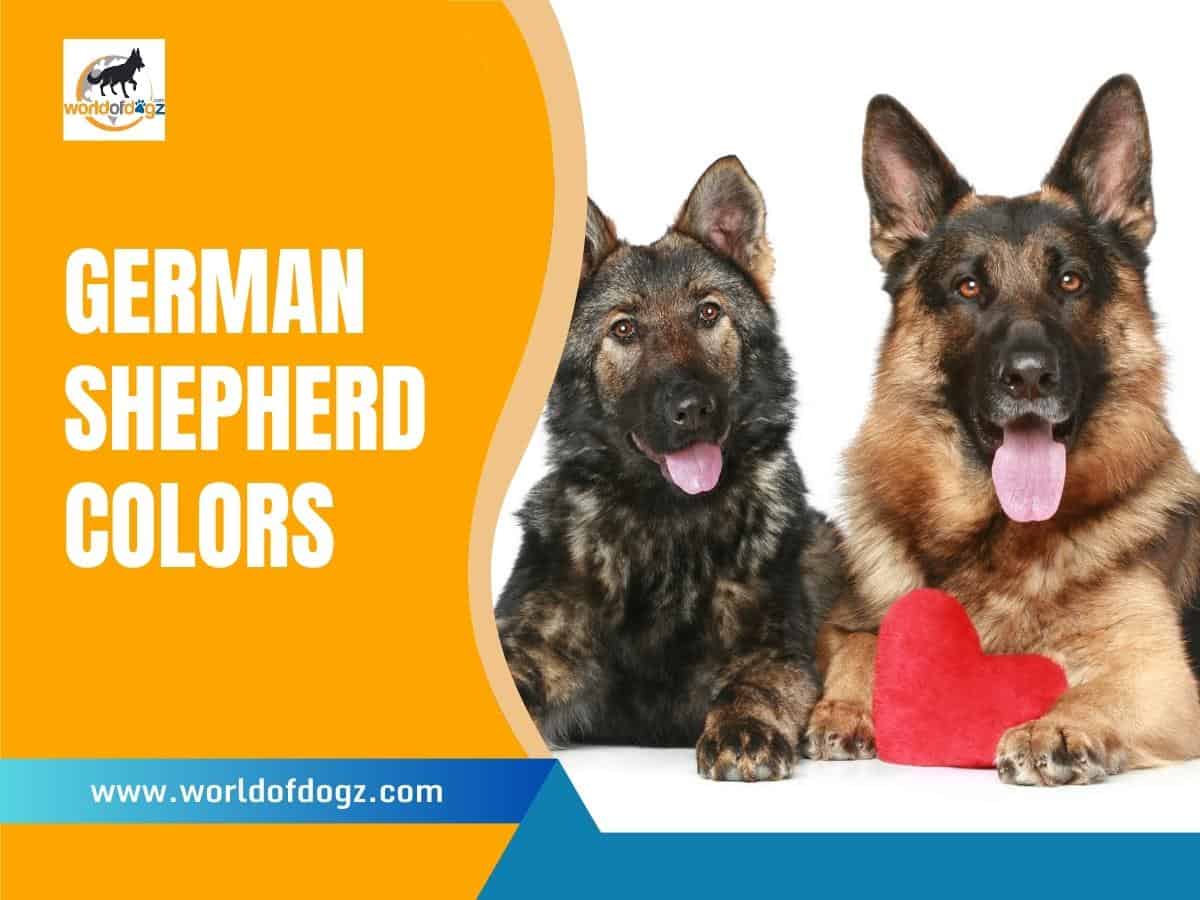
German Shepherd Color Varieties
German Shepherds can come in many types and a wide enough range of colors encompassing light and dark hues. These can be categorized as breed standard colors, rare, and whether they are seen as a fault in the eyes of the American Kennel Club.
| GSD Color | Standard, Rare, or AKC Fault |
|---|---|
| Black and Tan | Standard |
| Black and Red | Standard |
| Black and Silver | Standard |
| Black and Cream | Standard |
| Black | Standard |
| Bi-color | Standard |
| Sable | Standard |
| Gray | Rare |
| Isabella | Rare / AKC Fault |
| Blue (inc Blue and Tan) | Rare / AKC Fault |
| Liver (inc Liver and Tan) | Rare / AKC Fault |
| White | Rare / AKC Fault |
| Pale or Washed-out Colors | AKC Fault |
Black and Tan
Black and tan are seen as the standard color of German Shepherds because of how many GSDs present a black and tan appearance. Most working-line German Shepherds that aren’t monochrome are often tan in addition to black.
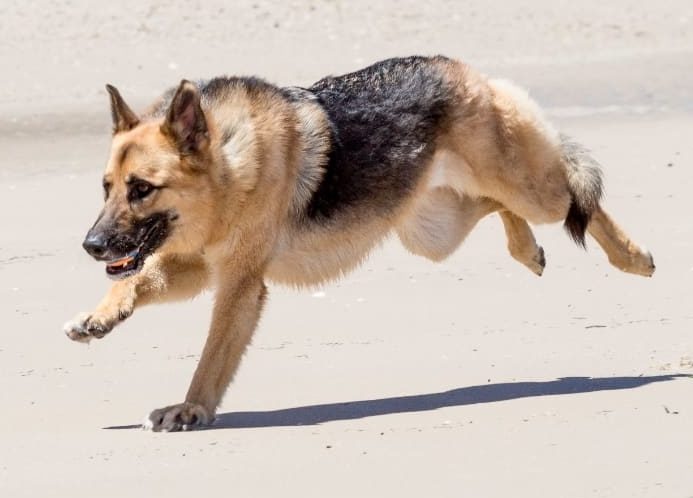
Despite being common among the working lines, this color doesn’t disqualify a German Shepherd from dog shows. It also doesn’t hurt the dog’s chances as much, as long as the tan is not too prominent and doesn’t lack vibrance.
With low saturation, tan color can look white, disqualifying a GSD from conformation events. If you’re adopting a black and tan puppy, you can expect the tan color to shift. And if the dog is primarily tan, you risk losing your show ring chances if he loses saturation upon maturity.
But since the color does not affect temperament or personality, getting a working line GSD that is black and tan is a sound choice. However, paying the show line price for a dog who might not get into dog shows is less than ideal.
Ideal for: Since they are usually working line dogs, black and tan GSDs are best for an athletic individual who doesn’t mind spending extensive periods training and exhausting the dog.
Black and Red
One of the most prominent colors among show line dogs, black and red, is often seen as a symbol of aesthetic beauty. It is often chased after as show-worthy, although dog show panels have no technical preference for this color.
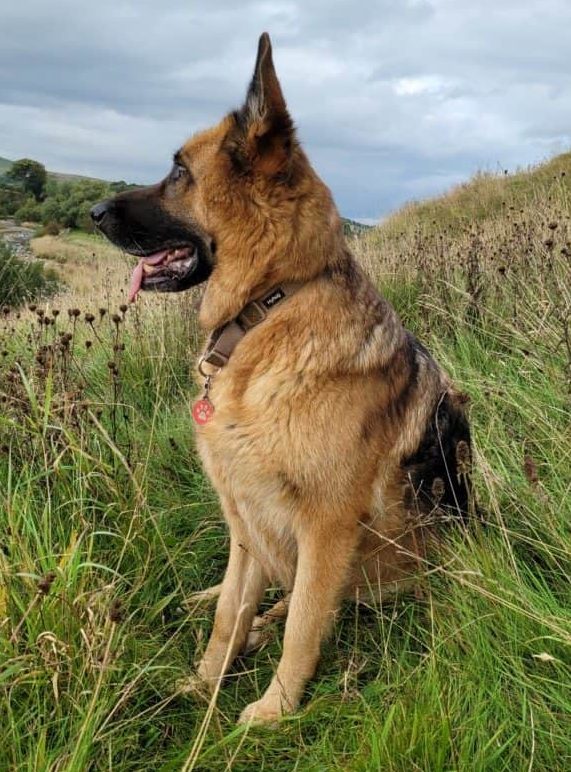
However, just like with sloping backs, previous champions pave the way for future breeding practices, so you will find many show-line German Shepherds featuring black and tan.
That said, this color is not exclusive to show line shepherds as working line GSDs bred with scarlet consistency shepherds can also end up with a black and red look.
Consequently, black and red is not an infallible indicator of a show-line dog but speaks for the dog’s chances of getting better points.
My German Shepherd is a black and red show line – but we don’t show her. We chose her for her excellent temperament and gorgeous looks.
Ideal for: With a ticket for acceptance into dog shows, black and red German Shepherds are for those interested in the show ring. They also make great pets.
Black and Silver
Black and silver GSDs are preferred visually by the outsider crowd. If you do not live by your local dog pageant’s Instagram feed, you can certainly make the call to get a black and silver German Shepherd based on its majestic looks. They have a stunning wolf-like appearance.
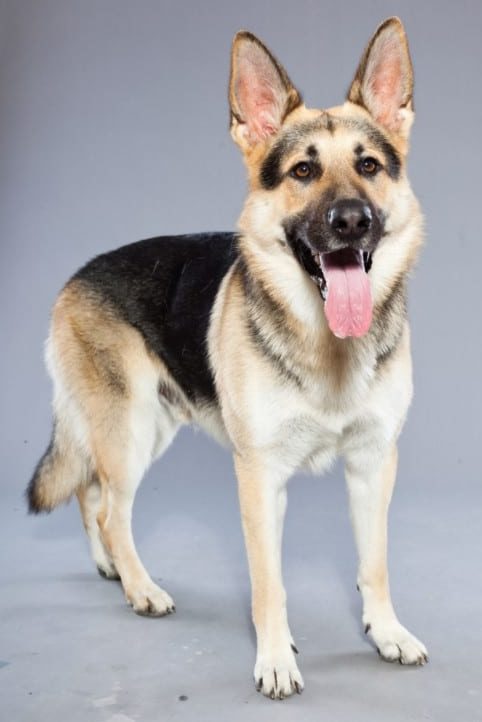
That said, dog shows will either see the silver as white and disqualify the dog or take it as tan and let the GSD enter, only to be marked down for not having a “rich” color. The silver in this type does look closer to the lightest shade of gray that doesn’t qualify as gray.
The silver color comes from the muted black gene. Although the apparent scientific and genetic evidence explaining the silver coat is unavailable in the coat color genetics of the German Shepherd, scientists have found out that they come from the A-series or the Agouti series.
Similar to other colors, silver also has no bearing on the temperament or health of the dog.
These dogs are also known as silver German Shepherds, silver sable, or black and silver sable.
Ideal for: Those inspired by wolves looking to adopt a dog that can bring an authoritative and secure vibe to the household can go for black and silver German Shepherds.
Watch All About The Silver German Shepherd In Our YouTube Video…
Black and Cream
Black and cream-colored German Shepherds are a variation of black and tan where the tan hasn’t matured. Some owners refer to them as black and champagne or fawn. Also, when a white German Shepherd has red in its background, it shows up as a cream color.
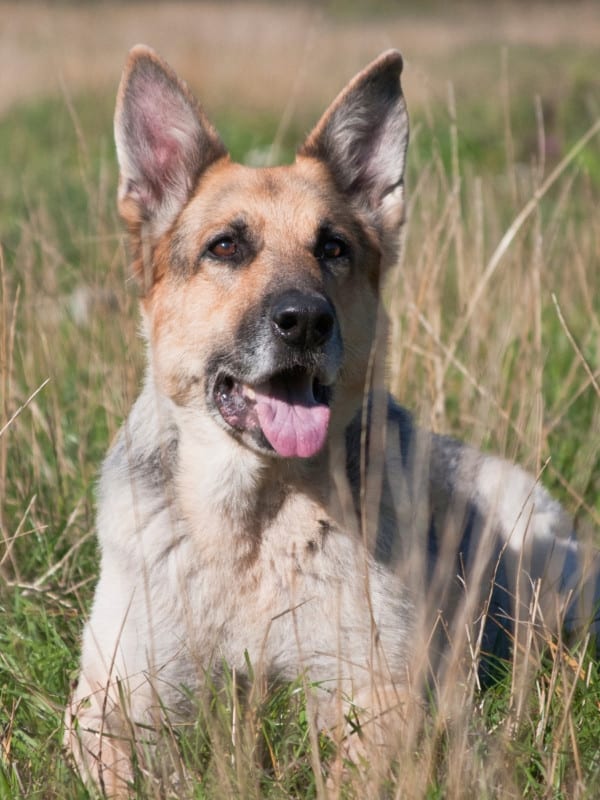
It is possible for particular black and cream German Shepherd puppies to grow into a black and tan look as they get older.
Still, you cannot guarantee how the colors will shift or if they will change in the first place.
Dog shows aside, black and cream dogs do not have the same intimidating look as darker dogs and can make for great gateway pets for those looking to adopt their first dog but find the alternative looks more intimidating.
Ideal for: Households with young children can adopt black and cream puppies as these GSDs are easier to accept for little kids.
Black
All Black German Shepherds have no shot at dog shows but are much better at something else: guarding. While the dog’s color does not affect his temperament, his look does affect how strangers react to it.
Since the black color correlates with night and darkness and there’s less cultural appreciation of darker animals as harmless pets, a black dog is immediately seen as a guard.
This perception comes with the added assumption that your black German Shepherd is well-trained to deal with intruders. Even though these dogs are great at discouraging intruders, they have excellent temperaments and empathy to be family dogs.
Black GSDs are not more aggressive than other varieties. and do not generally cost more. Unlike solid black, most puppies only show their actual color weeks after birth. They also make shedding less annoying as the black hairs are less visible.
A recessive gene causes the black color. Some black dogs have gold eyes, as shown in the image. Ruskin House of Shepherds states, “The solid black with the gold eyes usually means they carry color.”
Ideal for: Gated properties can benefit from solid black German Shepherds as these dogs keep intruders away without even having to bark. Large houses are also perfect spacious places where such dogs must exhaust their excess energy.
I think the solid black variety is stunning – I’d love to get one for my next pup.
Bi-color
Bi-color German Shepherds aren’t a different type of GSD; they are a meta-color encompassing a range of shades. A bi-color features two colors, one of which is often black. Most will appear all black with brown feet or legs, as shown in the image.
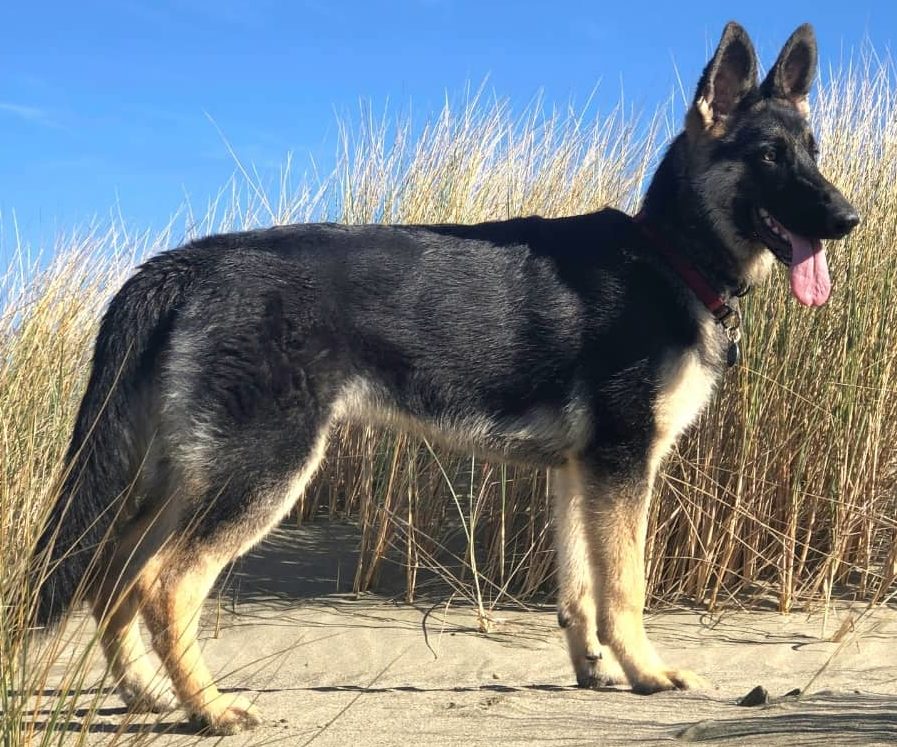
The AKC pioneered this categorization, which is most relevant to dog shows where solid-colored and bi-colored dogs are judged differently. Otherwise, it doesn’t matter if your dog is bi-colored or solid.
Among bi-colors, you should opt for darker ones if you plan to show the dog and lighter ones if you’re in the market for a friendly-looking dog that doesn’t scare your kids.
Ideal for: Being quite broad, this is ideal for almost everyone who isn’t insistent on having a solid-color GSD. Depending on the specifics of the color, the dog-and-owner fit can vary.
Sable
Sable is a pattern often seen as color because of its visual impact. The sable color is named after the mammal sable, which also has a similar color. This type of German Shepherd has black peppered across its fur, giving a deeply crimson color that looks nearly indistinguishable from black and liver.
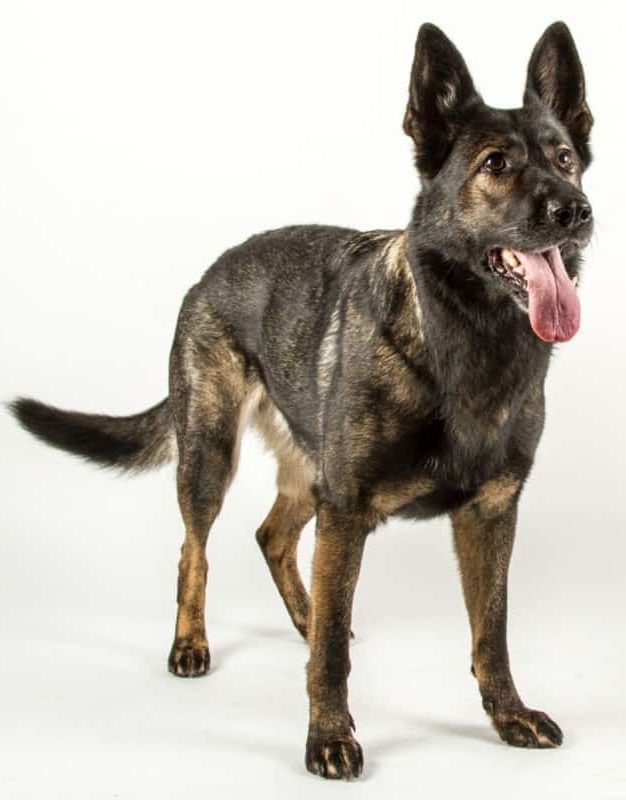
The sable coat pattern appears visibly black as each hair has a black tip. Sable colors include black sable, gray sable, tan sable, red sable, and silver sable.
If you like the look of this color pattern, head over to this article to learn loads more about this gorgeous variety: Sable German Shepherd.
Ideal for: This shepherd dog is best for those living in sun-kissed suburbs where the true color of sable German Shepherds shines.
White
Featuring the look of a bleached wolf, the all-white German Shepherd is entirely white and represents quite the irony. It is often purchased because of its exotic looks but is also seen as flawed enough to be disqualified from the show ring.
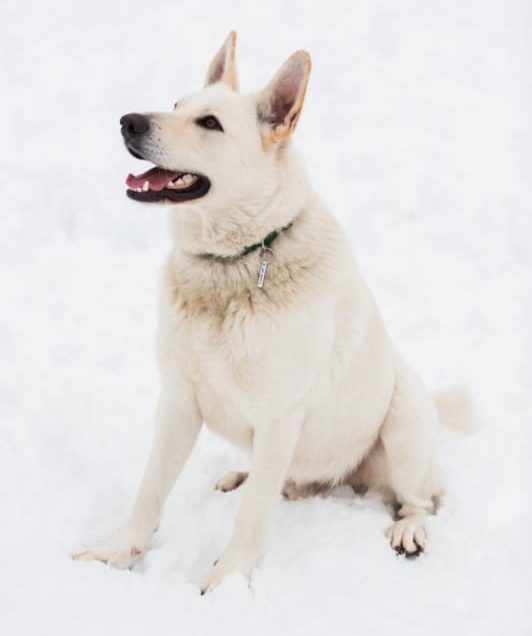
In other words, it represents the positive and the negative results of judging dogs by their looks, where they are simultaneously loved and discriminated against because of their color.
Given that the first German Shepherd was black, this dog is visually the farthest from its ancestors.
There is often a misconception that this type is a mixed breed. However, the white German Shepherd is definitely purebred.
Ideal for: Families with young toddlers can benefit from getting a non-intimidating dog. Even if you’re single and live next to a family, getting a white GSD is a more socially conscious choice. You can learn more in our YouTube video below…
Gray
Gray German Shepherds are seldom light gray as that color is categorized as cream. This leaves behind bi-color German Shepherds featuring black and a specific hue of tan that gives an overall deep gray look.
They are often gray sable. However, many gray dogs have no black pigmentation, differentiating them from the sable.
They have an aesthetic appearance and can tip top between work and show, though they are best kept as multifunctional pets. They look intimidating enough for strangers but acceptable even for younger children who have never had a big dog as a family pet.
Nonetheless, they are pretty rare, so you may have to find a specialized breeder to adopt one.
Ideal for: Families with younger children can benefit from these German Shepherds’ balanced, family-friendly, and stranger-intimidating look.
Blue (and Blue & Tan)
Blue German Shepherds aren’t navy blue or sky blue. Instead, they have a muted black color responsible for a blue-gray shimmer when the light hits the GSD’s coat. The color is rare because it is improbable to guarantee when breeding a single blue stud and rare to occur spontaneously.
Breeders also avoid propagating this type of Shepherd because they aren’t likely to qualify for or win dog shows. And the ones who breed rare GSDs only charge a lot per puppy.
Since blue is a manifestation of black, it can appear in all German Shepherd looks that feature the black color.
A stud manifesting the blue gene will never be bred with a show-line dog, as it is considered a waste of show genes when the resultant offspring has a 25% chance of being blue, making them unfit for shows.
Therefore, these dogs are bred mainly in the working line, where black and tan are the most common colors. That makes blue and tan the most common bi-color look of blue German Shepherds.
Ideal for: Individuals looking for an exotic, rare dog with a story would love to have a blue German Shepherd.
Liver
Liver is a color term used almost exclusively to describe dark brown dogs. The shades of dark brown can vary, but the term stands. It is no different for German Shepherds, who are also categorized as livers because they are dark brown.
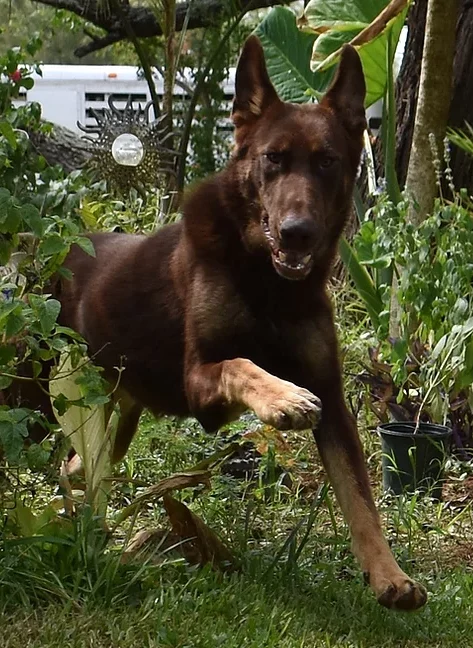
With black not really being seen as color – white as a complete lack of color, brown has the best shot of getting the highest points for color richness – except in the show world. This is because the American Kennel Club sees livers as faults, and they cannot enter the show ring.
However, liver German Shepherds are highly sought-after, making them some of the priciest German Shepherds to acquire.
Liver German Shepherds aren’t as rare as some color types, though, as the probability of liver offspring or bicolor liver puppies is much higher with liver studs. Still, their price is artificially inflated because of demand.
Ideal for: Those who love the deep brown aesthetic will love a liver German Shepherd. They can hike to sun-kissed places where this color’s brilliance is most apparent.
Liver and Tan
As mentioned earlier, German Shepherds with liver parents are pretty often liver-colored. That’s because the liver isn’t a mutation-dependent look like blue or silver.
While mutations did occur to manifest this look into the otherwise black line of GSDs, the genes of these dogs are relatively stable, making them great studs.
Ideal for: Owners with prominently brown wardrobes can get a kick by extending their color preference to their dogs.
Isabella
Isabella German Shepherds face the same ironic fate as white GSDs, where they are simultaneously admired and acquired for their beauty yet disqualified or marked down from shows for their looks. Similar to liver dogs, the AKC views them as a fault.
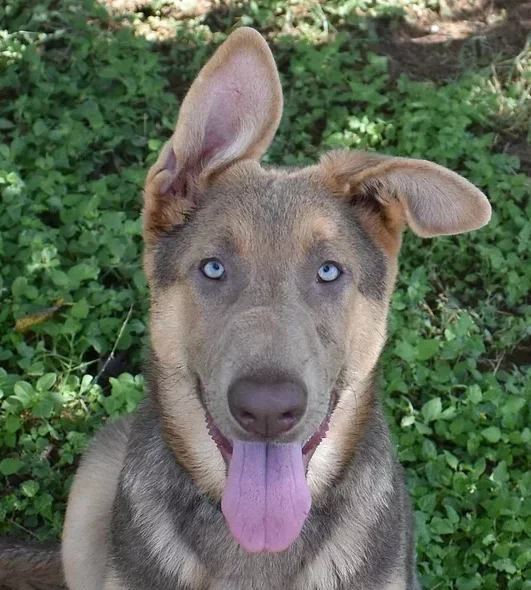
Isabella GSDs look lavender-flavored cappuccino in that they are a light lilac color.
They have a distinctly feminine appearance regardless of gender and can make a beautiful addition to the family. Because of their non-threatening looks, they are readily accepted in suburban communities, whereas new pets can often get scrutinized unfairly.
Isabella GSDs are rare because they come from a combination of recessive traits that might not even manifest in studs. Studs often have desirable dominant features, including rich colors.
The Isabella color comes from the combination of liver and blue, one of which is rarely used for breeding. This leaves room only for blue genes to pass through non-blue studs, which is not entirely likely.
As a result, Isabella GSDs are the rarest German Shepherds.
Ideal for: Those who want to make a statement with one of the rarest German Shepherds will be satisfied with an Isabella dog. However, they better be willing to pay the premium.
Color Patterns
Sable
Sable is actually a pattern that is often seen as a color. That’s because this pattern is color-contingent.
You cannot have a Sable Shepherd without having reddish fur. But the distribution of red and black or silver and a lot of black is what matters: the lighter coat makes up the backdrop over which the darker fur is peppered.
Sable shepherds are rarely sable all over, and portions of their bodies feature only one of the two colors that make up their sable pattern. In other words, given black and red as primary sable-makers, these dogs are more likely to be black and sable or red and sable.
Sometimes, you can get a rarer color sable, such as the liver sable in the image. Find out more in our below video…
Brindle
Now that you know that the sable pattern is bound by the colors that make it up, you might wonder what happens if red is missing from the pattern.
Brindle German Shepherds are the closest to sable in that they also consist of one color peppered across another in tiger stripes or a marbled pattern.
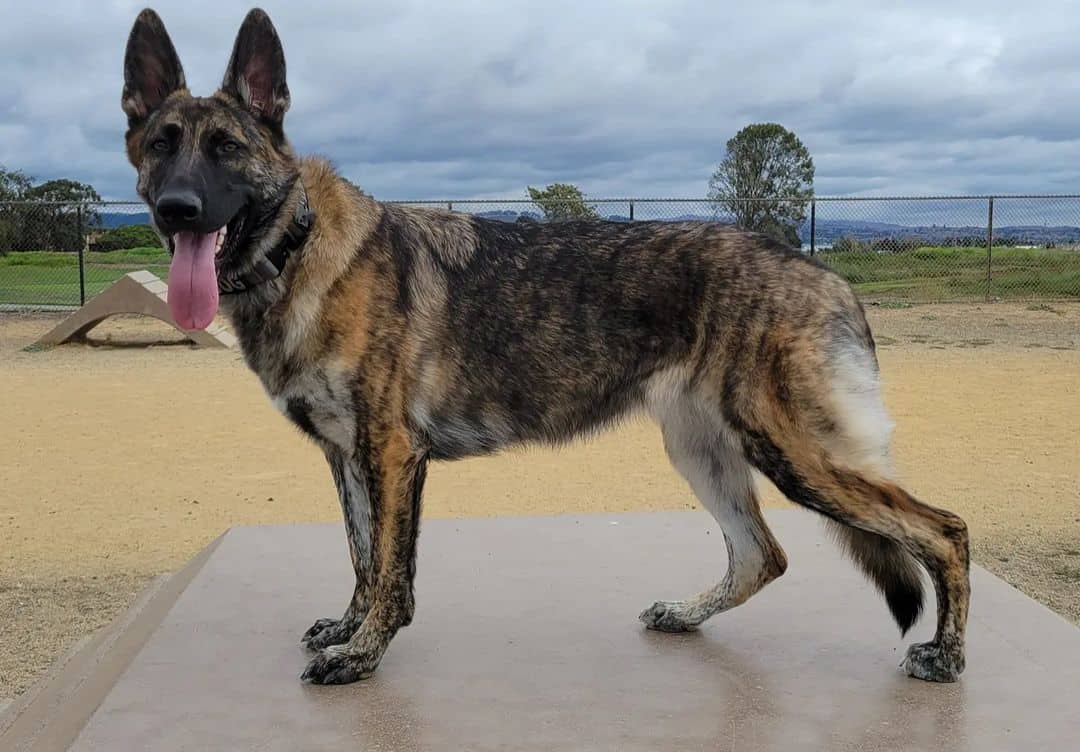
The colors in brindle shepherds are black and gray if not black and tan. Black is far more prominent, and these dogs are the closest to the second generation of German Shepherds.
They are generally referred to as black brindle, brindle tan, brindle gray, and brindle sable, as seen in the image
They are seen as a “washed-out” color by the American Kennel Club and cannot enter the show ring.
Panda
A Panda German Shepherd looks like a white or bi-color dog who tried to apply eye shadow for the first time. The area around their eyes is black, reminiscent of a panda. This parallel is also the reason for this pattern’s name.
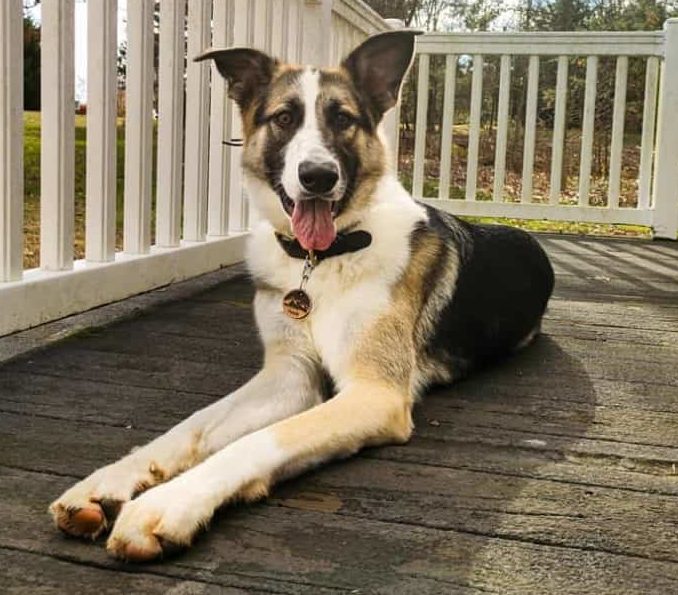
However, panda GSDs don’t have a different color only around their eyes. They have white color featured across their chest, limbs, feet, and tail tip, similar to a Border Collie.
Panda Shepherds do not have any other similarities with the panda; the dog has an active temperament compared to the lazy panda.
The dog results from the mutated “Panda” gene, which is not to be confused with the recessive S locus that causes white markings in the German Shepherd.
The dominant gene means only one parent can replicate the pattern. It is also seen as a fault for conformation.
White Markings
In most cases, this isn’t a permanent German Shepherd color, as you can find white spots in areas like the chest or paws of young, light puppies who shed the white fur upon maturing.
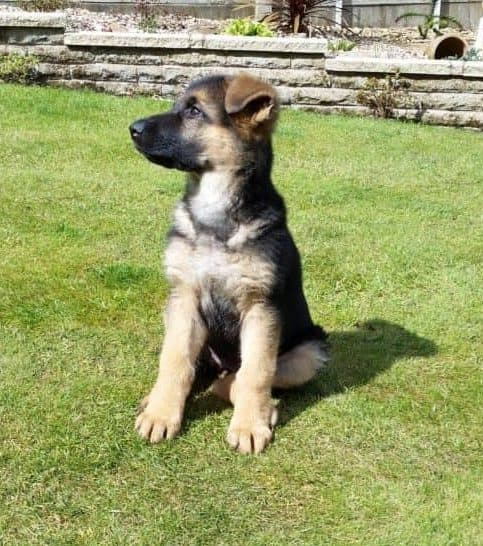
Still, getting a German Shepherd puppy with many white spots is a risk if you plan to enter him in a dog show as an adult.
But if you do not care about dog shows, the white markings can be charming. It is rarer to find white spotting in black GSDs. These spots are more common in black and red, black and cream, black and tan, and liver variations.
Saddle
The saddle is one of the few GSD patterns independent of color. A German Shepherd can have a black, blue, silver, or brown saddle, though other colors are not definitively excluded.
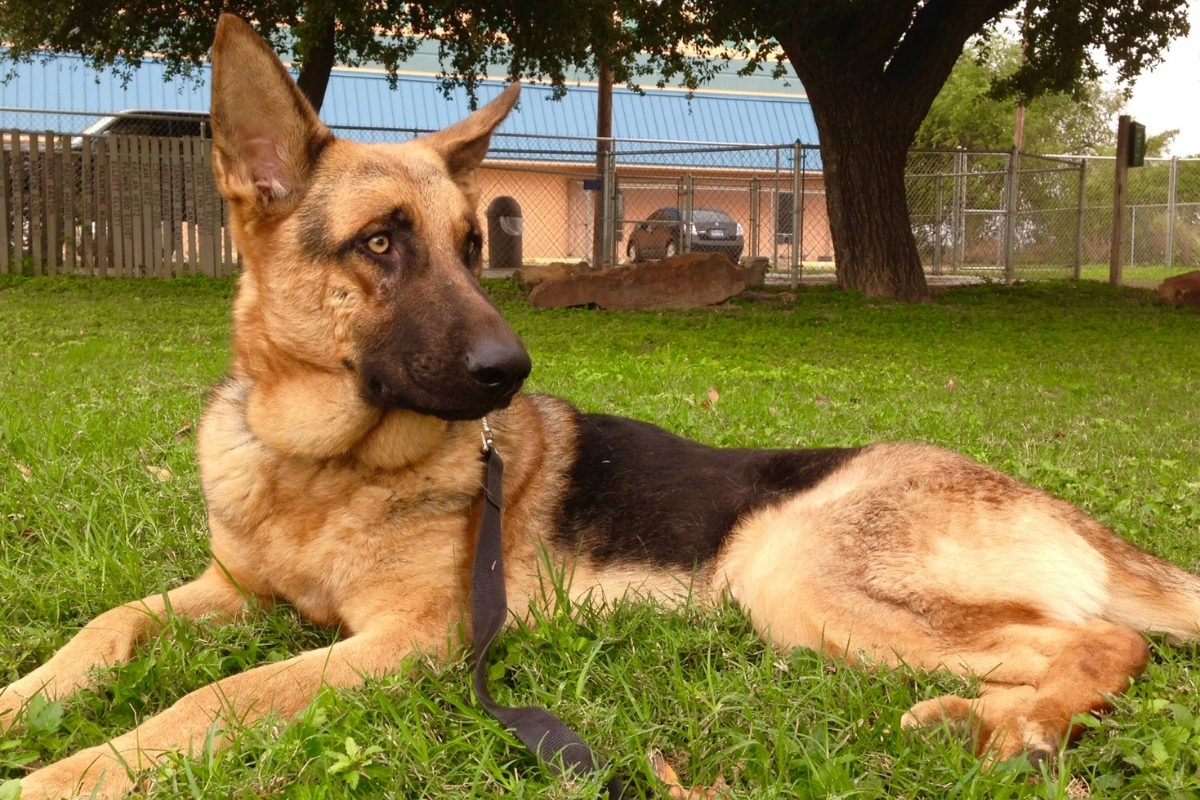
Like a saddle on horseback, the saddle takes up a prominent spot across the dog’s back and hunches down to the left and the right.
Some saddles can leave only the dog’s belly open to the other colors, while others are small enough to barely cover the sides.
Saddle-back German Shepherds have to be bi-color by definition because the saddle is visible only in contrast with another, often lighter, color.
Blanket
The blanket is yet another pattern independent of color. The darker shade goes beyond a saddle and covers almost the entire visible surface of the German Shepherd’s back, leaving only a portion of the dog’s limbs and some of the chest occupied by contrasting-colored fur.
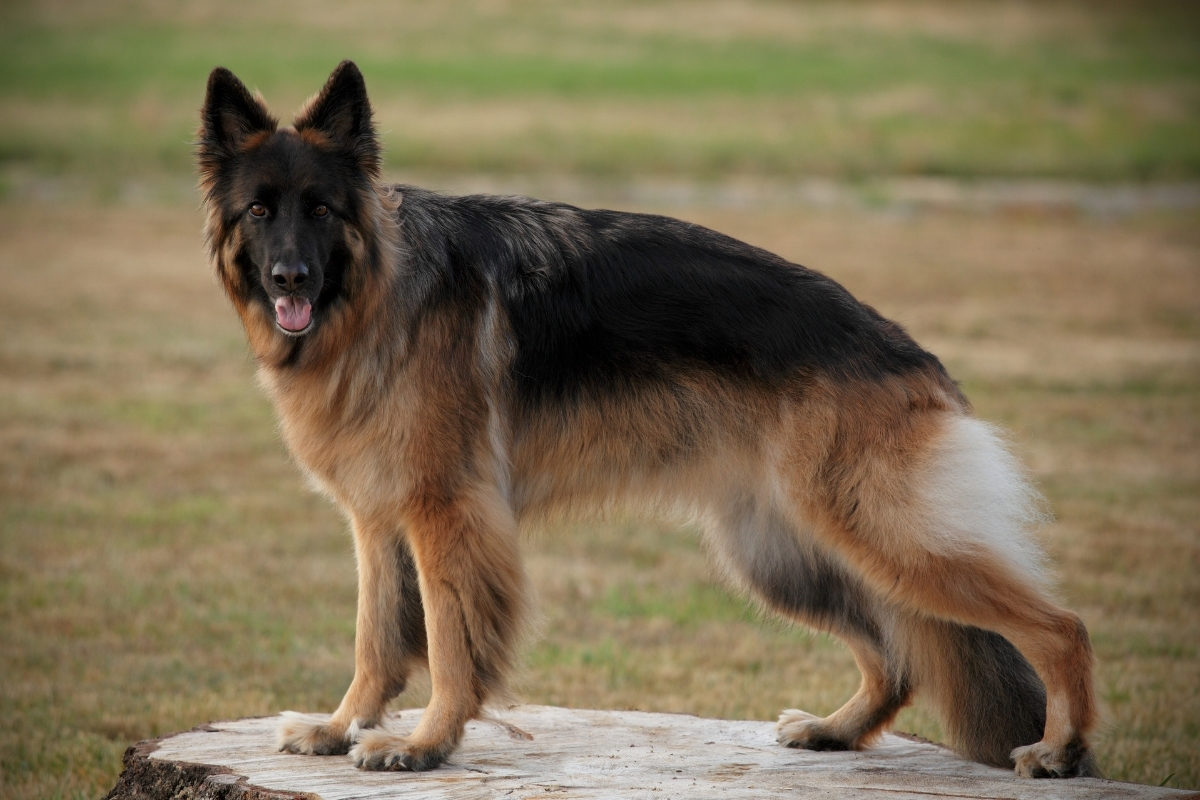
Given this description, the term “blanket” is self-explanatory. Like with saddle GSDs, being bicolor is a prerequisite for spotting the blanket.
The saddle pattern has a better shot at dog shows between saddle German Shepherds and blanket ones. That’s because the blanket does not leave room for the alternative color, usually red, cream, tan, or silver, to be as prominent.
Since the blanket is dark, dogs with this pattern have an intimidating presence and are often used by the police and protective patrols. This makes them excellent guard dogs as they carry the same connotations.
Mask
Mask refers to the face of a German Shepherd with visible contrast in the face compared to the surrounding region. You’ll notice the contrast between the face and the surrounding area, not the face and body.
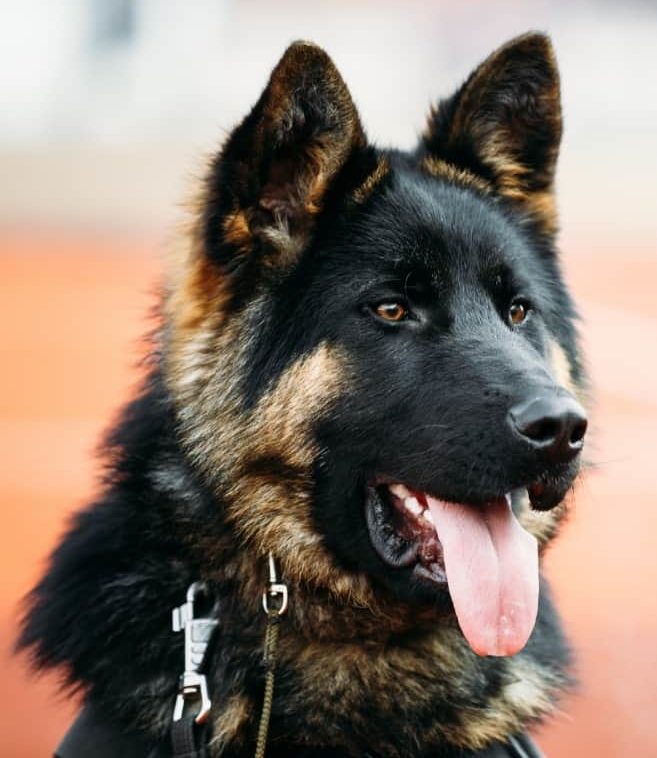
That’s because mask-pattern German Shepherds can have multiple patterns. On the one side, they can have black fur over their faces, which gives the appearance of a mask, but the rest of their body can feature stripes (brindle) or the sable pattern.
This study of dogs with colored masks found that the mask is caused by a specific allele referred to as a melanistic mask.
Mask German Shepherds have a unique appeal, which makes people go to great lengths to acquire them.
The mask is almost always black. A lighter mask is categorized differently.
Wolf Mask (Reverse Mask)
Wolf Mask German Shepherds have reverse panda and partial mask markings, making them look like Siberian Huskies, if not wolves.
The wolf mask resembles wolves in that the region around the eyes is light, with darker fur covering the rest of the dog’s head. The area around the mouth can be lighter, making the German Shepherd look more like a wolf.
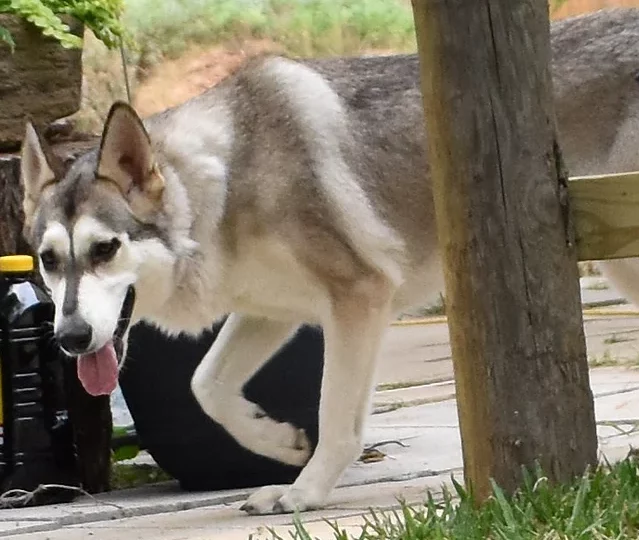
Some reverse masks also have a dark stripe down the muzzle, as in the image shown. The wolf mask, also known as the Hobo mask, is named after the dog from The Littlest Hobo TV series.
The first wolf mask German Shepherd was Baron von Der Krone, the son of the first GSD Horand von Grafrath.
Needless to say, these German Shepherds can be pricey simply because they resemble wolves. They are also intimidating because of this similarity. All the connotations they have with wolves, and their wildness come in handy when scaring away intruders.
Sometimes, though, they get overlooked during adoption quite unfairly because people assume they’d be more challenging to control than the standard German Shepherd. However, this is a myth, as they are as easy or difficult to raise as regular dogs.
To breed them, you must have both the mother and the father, who wear the same reverse mask.
Like the masked variety, German Shepherds with a reverse mask can have other patterns as the mask (or the reverse) has to do with their faces.
Speaking of wolves, the closest a GSD can come to having a wolf-like appearance is to have a reverse mask look and be a blanketed silver sable.
FAQs
What is the Rarest Colored German Shepherd?
The rarest color of German Shepherd is Isabella, which is also known as lilac. Not only is this color visually appealing, but it is also difficult to predict when breeding. The recessive blue and liver getting combined are not very likely, which makes almost all Isabella shepherds pleasant surprises.
Even though these dogs don’t win shows as they are seen as faults by the AKC, they are showstoppers – and breeders who end up with one of these immediately add a premium to the price.
Getting a lilac shepherd from a reputable breeder is advisable because unscrupulous breeders may repeatedly breed puppies and neglect the non-isabella dogs, hoping to profit from the lilac pups.
What is the Most Common Color of a German Shepherd?
Black is prominent across most variations of GSDs. From black and tan, often working lines, to black and red for showing, most German Shepherds have a hint of black.
If you are looking for the most common overall color of a German Shepherd, the two that come out on top are black and red and black and tan. The show line dog of this bicolor look will be the cheapest yet command a price significantly higher than a working dog of the same pair of colors.
Why are Some German Shepherd Colors Controversial?
Some German Shepherd colors, such as blue and white, are controversial because they have been linked to genetic health issues, such as skin problems and deafness.
Breeders who prioritize these colors over health can perpetuate these issues. It’s important to choose a reputable breeder who prioritizes the health and well-being of their dogs over their appearance.
Can You Predict The Color of a German Shepherd Puppy?
Yes, the color of a German Shepherd puppy can be predicted based on the colors of the parents and the genetic inheritance of the color genes.
By understanding the basics of color genetics, breeders can make educated guesses about the colors of their puppies. However, it’s important to remember that genetics is not an exact science, and there is always a degree of unpredictability when it comes to breeding.
Do German Shepherds Change Color?
German Shepherds do change color, especially if they are bicolor. This happens when they mature and shed certain colored fur but never grow it back. The color change is most prominent in brindle GSDs and sable shepherds, as the decrease in one shade of fur leads to a change in the overall look of the dog.
That said, you should never purchase a German Shepherd puppy, hoping it will change color because if it doesn’t, you will be disappointed in your dog for something that isn’t his fault. German Shepherds are extremely intelligent and can pick up on your energy or lack thereof, affecting your dog’s self-esteem.
Does the Color of a German Shepherd Affect its Temperament?
No, the color of a German Shepherd does not affect its temperament. Temperament is determined by genetics and upbringing, not color. However, it’s important to remember that specific colors, such as white, may be associated with certain health issues, which can indirectly affect temperament.
Can German Shepherds have two different colored eyes?
German Shepherds can indeed have two different colored eyes, a condition known as heterochromia. This unique trait adds to their overall charm and individuality, making them even more captivating.
Can two black German Shepherds have puppies of different colors?
Yes, it is possible, as this is because the genetic makeup of the parents, including the presence of recessive genes, can influence the coat color variation in their offspring.
Related Posts You May Like:


